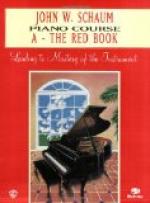“When a new pupil comes, I must make a mental appraisement of his capacity, his likelihood to grasp the subject, his quickness of intelligence, his health, and so on. No two pupils can be treated in the same way. One who has little continuity, who has never followed out a serious line of thought in any direction, must be treated quite differently from one of an opposite mentality and experience. It would be useless to give Bach to the first pupil, it would only be a waste of time and patience: he could not comprehend the music in any sense; he would have no conception of the great things that Bach stands for. Such a course of treatment would only make him hate music; whereas to one of a more serious and thoughtful turn of mind, you might give any amount of Bach.
“A student with a poor touch and undeveloped hand, must go through a regular course of training. The hand is first placed in position, either at the keyboard or on a table; the fingers are taught to start with up movements, as the lifting muscles need special attention. A muscle or a finger, is either taut, flabby or stiff; it is the taut condition I strive for—to make the finger responsive, like a fine steel spring.
“It is absolutely necessary to establish correct finger action at the outset; for the sake of finger development, clearness, and accuracy. When single fingers can make accurate up and down movements, we can put two fingers together and acquire a perfect legato. I teach three kinds of legato—the passage legato, the singing legato, and the accompanying legato; the pupil must master the first before attempting the others. I advise technic practise with each hand alone, for you must know I am a firm believer in the study of pure technic outside of pieces.
“As the student advances we take up chord playing with different touches, scales, arpeggios and octaves. I institute quite early what I call polyphonic technic—one hand doing a different movement or touch from the other. This works out in scales and arpeggios with a variety of touches—one hand playing a passage or scale staccato while the other plays legato, and vice versa.”
Asked if he taught technical material without a book, Mr. Heffley replied:
“No, I generally use the Heinrich Germer work, as it covers the ground very satisfactorily; it is compact, concise, and complete in one volume. I also use Mertke to some extent. Every form of exercise must be worked out in all keys; I find the books useful for all kinds of students. I may add that I use comparatively few etudes.
“If the student seems to have a very imperfect rhythmic sense, I use the metronome, but as sparingly as possible, for I want to establish the inner sense of rhythm.




